
|
xTuple ERP Reference Guide |
Employees are people who work for your company. An employee may or may not be an xTuple ERP system user. To create a new employee navigate to . You'll see the following screen:

When creating a new employee, you are presented with the following options:
Enter a code to identify the employee. This is the same as the employee's CRM account number.
Enter a number to uniquely identify the employee. This is the same as a badge number for the employee.
Enter the full name of the employee. This is the same as the employee's CRM account name.
Select if the employee is currently active. Not selecting makes the employee inactive.
Manually enter employee contact information in the fields below—or use the lookup features to select pre-existing contact and address information.
If new contact or address information is manually entered here, that information will be added automatically to the master list of Contacts and/or Addresses.
The following buttons are unique to this screen:
Select to open the employee's account.
To associate an image with an employee, select the tab. The following screen will appear:

When associating an image with an employee, you will be presented with the following options:
Select an image from the list of available images to associate with the employee. You can learn more about adding images to the database here Section 13.2.10, “Images”.
To specify administrative details related to an employee, select the tab. The following screen will appear:
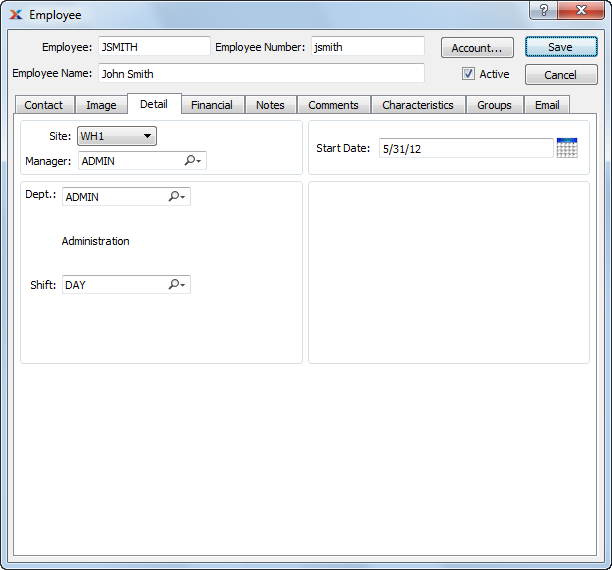
When specifying administrative details related to an employee, you will be presented with the following options:
Specify the site (i.e., site, store location, etc.) where the employee is principally located.
Enter the name of the employee's manager.
Specify the employee's department.
Specify the shift the employee generally works.
If you have the ability to create new xTuple ERP system users, then select this option to create the employee as a system user. If the employee is already a system user, then this option will already be checked.
To ensure correspondence between the employee record and the system user record, the employee name should match the employee's system username.
Select if the employee is a sales representative. If the employee is already listed as a sales rep., then this option will already by checked.
To view financial information related to an employee, select the tab. The following screen will appear:
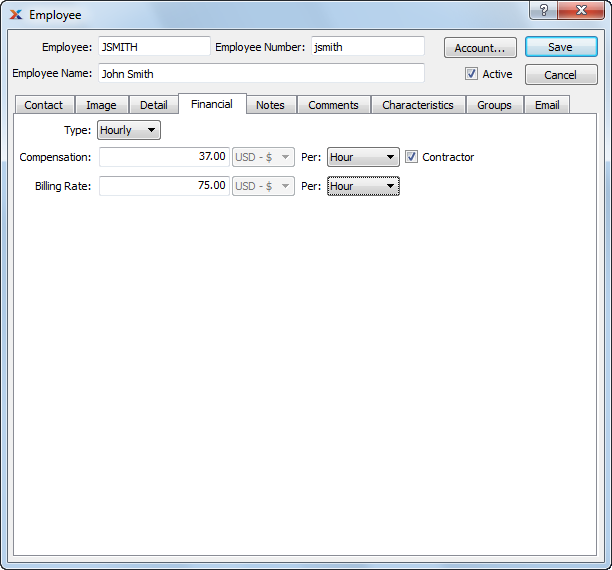
When viewing financial information related to an employee, you are presented with the following options:
Specify whether the employee is paid hourly or on a salary basis.
Enter the amount of the employee's compensation. The amount may be specified per hour, day, week, bi-weekly, or year.
Check this option if the employee is a contractor.
Enter the rate used when billing customers for the employee's time. The rate may be specified per hour, day, week, bi-weekly, or year.
To add notes to an employee record, select the tab. The following screen will appear:

When adding notes to an employee, you are presented with the following options:
This is a scrolling text field with word-wrapping for entering notes related to the employee. Any notes entered on this screen are for internal purposes only.
To add comments to an employee, select the tab at the bottom of the Employee screen. The following screen will appear:
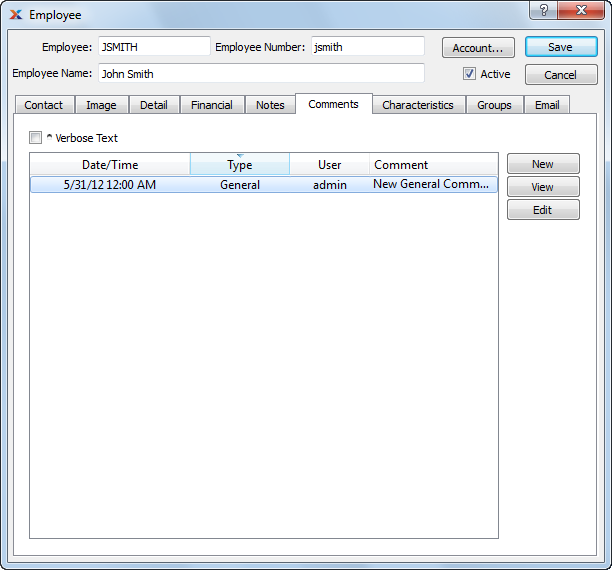
When adding or reviewing comments, you are presented with the following options:
Select to display all comments in the list in an expanded view which includes the entire text of each comment. To edit a comment, simply select the link next to the comment. That link will not be shown for changelog comments, which can't be edited. If the Verbose Text option is not selected, the comment list will display only header level information for each comment.
Display lists comments related to the record.
The following buttons are available:
Opens screen for creating a new comment.
Highlight a comment and then select this button to reach a read-only view of the Edit screen.
Enables you to edit highlighted comments—as long as the comments are not changelog comments. ChangeLog comments are system-generated and may not be edited. The Edit screen is the same as that for creating a new comment—except that when editing, the fields will contain comment information. Double-clicking on a comment will also bring you to the editing screen.
To enter a new comment, select the button. The following screen will appear:

Select a comment type from the drop-down list to classify the comment. This is a required step. Comment types may be system-defined (i.e., changelog and general) or user-defined, as described in Section 13.2.3, “Comment Types”. Once you have specified a comment type, begin typing your comment in the main text area. The text area features word-wrapping and scroll-bar support for longer comments.
The following buttons are unique to this screen:
Select to show the complete list (i.e., thread) of comments associated with the record. To hide the list, simply select the button again. The comment thread will show the most recent comment first.
Employee characteristics are user-defined definitions of an employee which may be used to provide additional layers of description. To enter characteristics associated with an employee, select the tab. The following screen will appear:
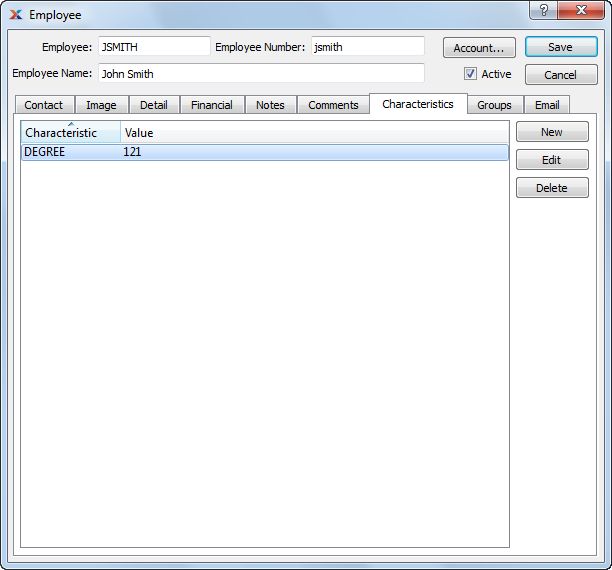
To create a new characteristic for your current context, select the button from the characteristics list. The following screen will appear:

When creating a new characteristic, you are presented with the following options:
Select a characteristic from the list of characteristics available for your current context. To learn more about how characteristics are linked to specific contexts, please see Section 9.2.2.1, “Characteristic”.
Enter a value to associate with the characteristic.
In some contexts, the Default option will appear. Select if the value entered is the default value for the specified characteristic. Default values will always be listed first where characteristics are used.
To associate group memberships with an employee, select the tab. The following screen will appear:
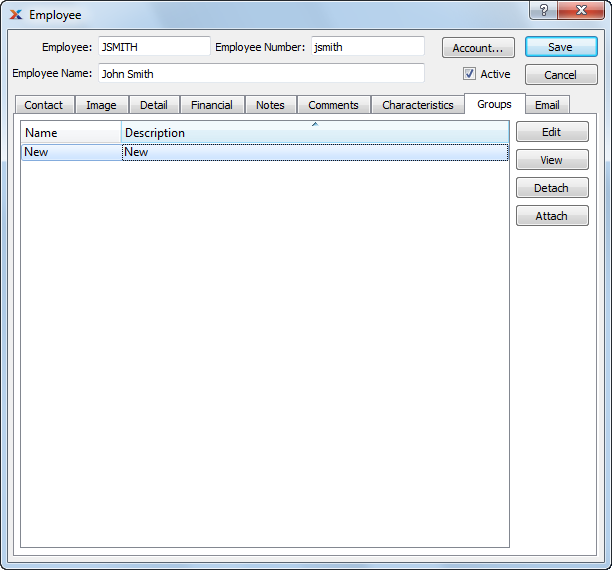
When associating group memberships with an employee, you are presented with the following options:
Enables you to edit highlighted employee groups. The edit screen is the same as that for creating a new employee group—except that when editing, the fields will contain employee group information. Double-clicking on an employee group will also bring you to the editing screen.
Highlight an employee group and then select this button to reach a read-only view of the Edit screen.
Highlight an employee group and then select this button to remove the association between the employee group and the employee.
Select to associate a new employee group with the employee.
To view email associated with the employee, select the tab. The following screen will appear:

When viewing associated emails, you are presented with the following options:
Display lists associated emails.
The content of a highlighted email will be displayed here.
Specify the maximum number of associated emails you want to be displayed in the email list. If the list is extremely long, you may experience some slowness when opening the screen.
Select to load all associated emails into the list.
Enter a string of letters or complete words to search for matches in the list of associated emails. The search will scan through subject lines, To addresses, and From addresses.
The following buttons are unique to this screen:
Select to send a new email, using the default email program on your computer.
Highlight an email and then select this button to print a copy of the email.
Highlight an email and then select this button to reply to the email's sender, using the default email program on your computer.
Highlight an email and then select this button to reply to everyone associated with the email, using the default email program on your computer.
Highlight an email and then select this button to forward the email to another person(s), using the default email program on your computer.
Highlight an email and then select this button to attach an email associated with a contact in your contact list.
Highlight an email and then select this button to remove the associated email from the list.